Last updated on May 4th, 2022 , 05:17 am
Call Option Definition: A call option is a contract between a buyer and seller that gives the buyer the right to purchase 100 shares of the underlying security at the specified strike price.
Put Option Definition: A put option is a contract between a buyer and seller that gives the buyer the right to sell 100 shares of the underlying security at the specified strike price.
Call Option vs Put Option: Put options are bearish market bets while call options are bullish market bets.
The first step in any beginner options trader education is understanding the fundamental difference between calls and puts.
In the stock market, there are only two types of options in existence: calls and puts. You can combine these options in numerous ways, creating strategies like the “vertical spread”, “iron condor” and “butterfly”.
Just like stocks, you can both buy and sell options. This article, however, is going to focus mostly on the differences (and similarities) between the basic long call and put options strategy.
Should you want to continue your education, we have provided a few links to more advanced options trading lessons at the end of this article.
If you are brand new to options, perhaps a better starting place would be comparing stock to options.
TAKEAWAYS
- Calls increase in value when the underlying stock rises and are thus bullish
- Puts increase in value when the underlying stock declines and are thus bearish
- Both calls and puts decrease in value when the underlying stock stays the same
- Calls and puts both represent 100 shares of the underlying asset (stock); calls convert to long stock and puts convert to short stock
- Maximum profit in calls is infinite; maximum profit in puts is defined
- Calls are in-the-money when the strike price is below the stock price
- Puts are in-the-money when the strike price is above the stock price
Calls vs Puts: Similarities
Before we understand how calls and puts differ, it will help to first understand how these two option types are alike.
Why? All options include standardized terms. Understanding the mechanics of these terms will make the differentiating of calls and puts much easier.
Before we look at 6 ways calls and puts differ, let’s first learn 6 ways they are alike!
1. Both Calls and Puts Are Derivatives
Derivatives are NOT stocks. With stocks, you have certain rights, such as the right to vote and receive dividends. Options have no such rights.
2. (Long) Calls and Puts Have the Right to Be Exercised
For American-style options, the owners of both long calls and long puts have the right to exercise their options contract at any time. All stock options are American-style.
- When a long American style call option is exercised, 100 shares of stock are purchased at the contract’s “strike price.”
- When a long American-style put option is exercised, 100 shares of stock are sold at the “strike price.”
European-style options, on the other hand, can only be exercised at option expiration. These options include index options. The underlying product of index options does not offer shares. These types of products offer advantages to traders that sell call and put options as early exercise is not possible.
3. Short Calls and Puts Have Assignment Risk
Because long American-style options can be exercised at any time, traders’ short call and put options can, in theory, be “assigned” at any time. Understanding the assignment process is important for short options traders. However, this usually only happens when an option is in-the-money and “extrinsic” value is very low.
- When a short American-style call option is assigned, 100 shares of stock are sold at the “strike price.”
- When a short American-style put option is assigned, 100 shares of stock are purchased at the “strike price.”
4.) Calls and Puts Both have “Time Decay” Risk
All options have a time frame. In an environment where the stock price and implied volatility remain constant, both call and put options will shed value as their expiration date approaches. This is known as the options Greek “theta“
Theta is bad for option buyers as this causes calls and puts to shed value. Short call and put options, however, profit from theta as time decay eats away at the premium sold.
5.) Calls and Puts Both Represent (Usually) 100 Shares of Stock
6.) Calls and Puts Both Rise in Value With Volatility
In the options market, the market price of calls and puts increase with rising implied volatility. The Greek “vega” tells us how sensitive an option is to changes in implied volatility.
Volatility is a positive for long options because it causes the value of both calls and puts to increase. This is negative for short options for the same reason.
So now that we understand how these types of options are alike, let’s see how they differ next!
1.) Calls vs Puts: Market Direction
In terms of market direction, calls and puts have completely different profiles.
Long Calls and Market Direction
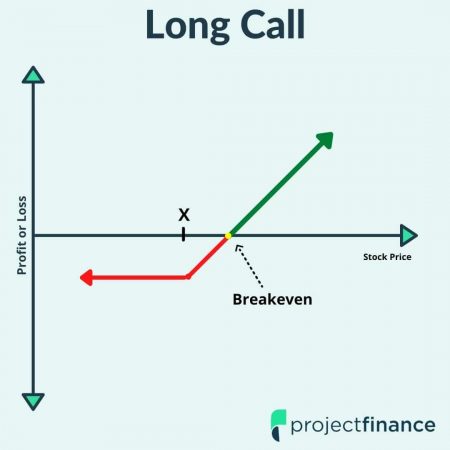
The above graph represents the profit/loss profile of a long call at expiration, where X represents the strike price of the call bought.
By studying the above chart of a long call at the option’s expiration, we can see that this options strategy becomes profitable as the underlying share price increases.
However, the underlying must rise in value fast and momentous in order for a call buyer to become profitable.
The further out-of-the-money a call option is, the greater the stock will need to rise in price to achieve profitability. In options trading, moneyness refers to the price of a stock in relation to an options strike price.
We aren’t going to focus too much on short options in this article, but if you’d like to get an idea of their payout profiles, just switch the green and red lines around in our respective call (and put) chart.
Long Puts and Market Direction
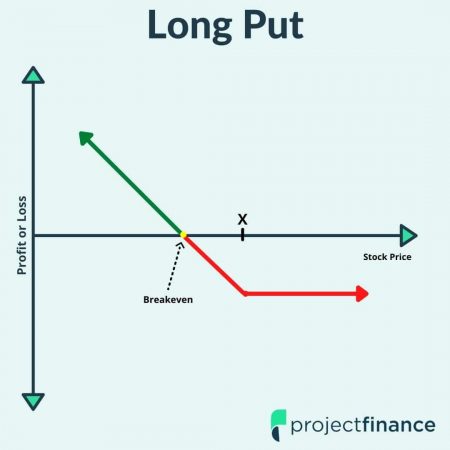
The above graph represents the profit/loss profile of a long put at expiration, where X represents the strike price of the put bought.
In order to understand put options, just take everything we learned about calls and flip it around. Puts increase in value as the underlying stock/security falls in value.
For a put option to be profitable, the stock must fall hard and fast. Just because a stock is down on a day doesn’t necessarily mean a put option will increase in value.
Like calls, the moneyness of a put option will determine how it reacts to changes in the underlying price.
2.) Calls vs Puts: Share Representation
As we learned from the “similarities” of calls and puts earlier, both types of options give the owner the right to “exercise” their option. This exercisement results in 100 shares of stock.
However, the type of stock that these options settles to is completely different!
- A long call option settles to 100 shares of long stock when exercised.
- A long put option settles to 100 short shares of stock when exercised.
So at what price is this stock bought or sold? The strike price of the option.
Long American style options can be exercised at any time.
However, this exercise/assign process rarely happens.
Why?
When you exercise an option early, you forgo that option’s “extrinsic” value. Both call and put options are composed completely of extrinsic and/or intrinsic value.
Extrinsic and Intrinsic Value
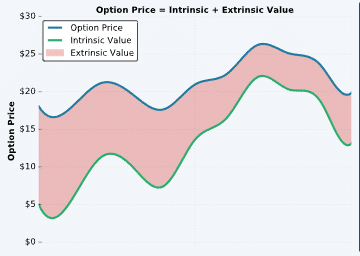
- Intrinsic value represents how deep in-the-money an option is, or simply how much value the option has on its own.
- Extrinsic value is made up of time and implied volatility. This value accounts for what could happen to our option in the future. Time is money!
Almost all in-the-money options have both extrinsic and intrinsic value. Out-of-the-money options are all extrinsic value.
Since extrinsic value is lost when an option is exercised, both in and out of the money options are rarely exercised.
Think of it this way – if a stock is trading at $148 and you are long the 150 call, why exercise your right to buy the stock at $150 when you can buy it in the market for $148, two dollars cheaper? You wouldn’t! You would just sell that option in the market. Options don’t have to be exercised to be profitable.
3.) Calls vs Puts: Maximum Profit
Calls become profitable as the underlying security rises in value; puts become profitable as the underlying security falls in value.
The maximum profit scenario, however, is much greater in calls than that of puts. Let’s see why next.
Maximum Profit in Call Options
The maximum profit on a long call is infinite.
Why?
A call option is a derivative financial instrument. The price of a call option is derived from that of a stock
A stock can (in theory) go as high as infinity. There is no ballast holding it down – it can fly to the moon.
NOTE! Our Maximum loss and profits are referring to only long options. Short options have MUCH MORE risk.
Maximum Profit in Put Options
We mentioned above that since a stock can go to infinity, the value of a call option on that stock can as well.
But what about put options?
Unlike calls, puts profit when a stock goes down in value. So how low can a stock go? Zero.
A stock can never go below zero, therefore, the maximum profit on a long put option is tethered to zero.
4.) Calls vs Puts: Maximum Loss
Whenever you purchase an options contract (call or put), the most you can ever lose is the option premium paid. You can compare this to stock – if you buy Apple (AAPL) at $150/share, the most you will ever lose is $150/ share.
If you purchase a call option for $2, the most you will ever lose is this $2. However, because of the “multiplier effect” of 100 we discussed earlier, the quoted price of an options contract does not represent the total dollar risk. An options contract quoted at $2 will cost us $200 – out total at-risk money.
For both call and put options, the maximum loss (or risk) is always the debit, or “premium”, paid.
5.) Calls vs Puts: Moneyness
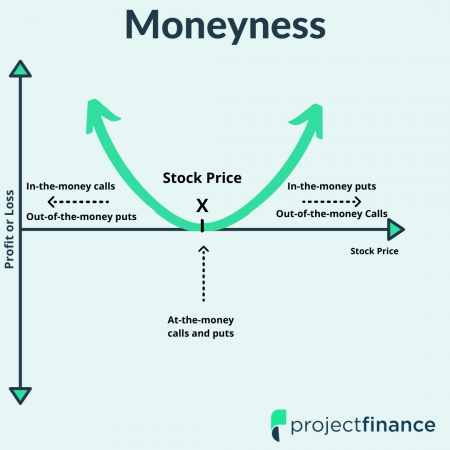
All options contracts exists in one of three moneyness states:
- In-The-Money
- At-The-Money
- Out-Of-The-Money
Call options are in-the-money when the strike price is below the stock price. Call options are out-of-the-money when the strike price is above the stock price.
Put options are in-the-money when the strike price is above the stock price. Put options are out-of-the-money when the strike price is below the stock price.
Options almost always exist in one of these two moneyness states. However, when an options strike price is trading near the stock price, traders refer to these options as being at-the-money.
6.) Calls vs Puts: Dividends
Buying stock comes with benefits, such as receiving dividends.
We mentioned at the beginning of this article that neither calls nor puts receive dividends.
Call options do, however, react to dividends!
Why? Call Options give the owner the right to convert their contract into long stock. If the amount of a dividend gained is greater than the extrinsic value lost by early exercising, it makes sense for a long call position to be exercised.
Put options are converted to short stock. Since short stock does not receive dividends, it would not make sense to exercise a put during a dividend event.
Final Word
Comparing calls to puts is like comparing apples to oranges. Though they are both standardized in the same fashion, they react completely differently to rises and falls in a stocks value.
However, in some regards, they are indeed similar. If a stock doesn’t go anywhere, both calls and put will decrease in value. If the implied volatility of a stock increases, on the other hand, they will both rise in value together.
Calls vs Puts: FAQs
The main risk of call options is time decay. When stock price and volatility remain the same, options shed value. This is because of the Greek “theta”. Call sellers, however, profit from theta.
Calls and puts are opposite types of securities. Puts would be better to buy if you believe a stock is going to fall in value while calls would be beneficial if you believe a security is going to rise in value. However, for both calls and put to be profitable, the price of the stock must either fall (puts) or rise (calls) by a large amount.
Selling put options are better suited when you are neutral or slightly bullish on a security. Call options are best for very bullish markets.
If you buy a call option and the price of the underlying asset does not rise significantly, you will not make money. Selling a put in this situation would make money. However, selling puts has far greater risk than buying calls.
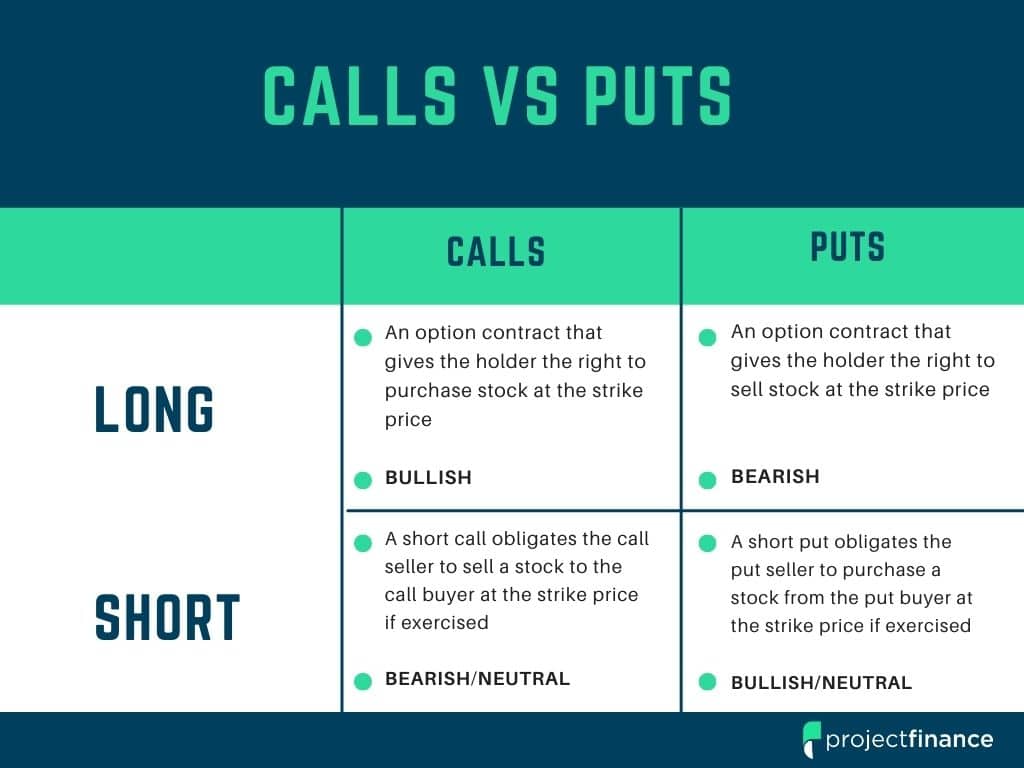
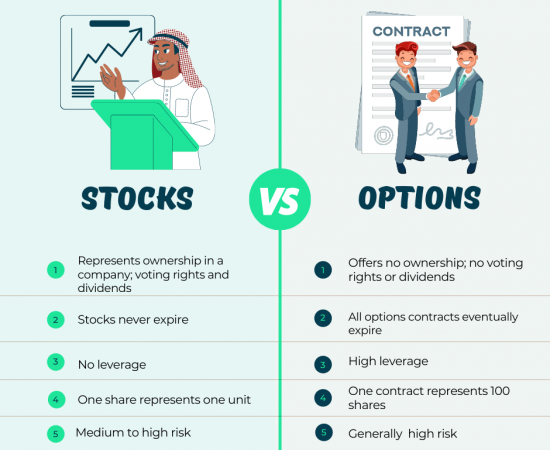

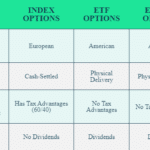

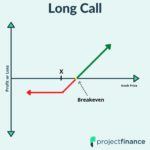
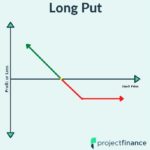
Thanks for the article!
I bought a call option that is going to expire today. I’m trying to sell the option before it expires but I can’t. It won’t even accept an order for 0.01. Any idea why? Thanks!
Thanks for the question Nefeli!
Unfortunately, it sounds like your call option is worthless. I’m guessing the strike price of your call is quite far away from the price of the underlying stock.
In these situations, exercising your call would have no benefit as opposed to simply buying the stock in the market. This is the reason that no party is willing to “buy” this call from you.
Mike